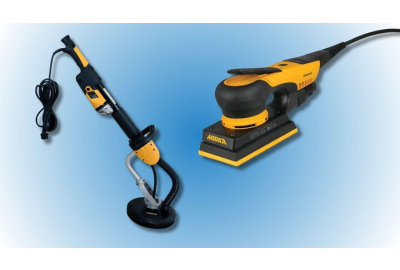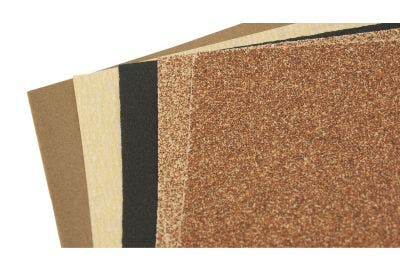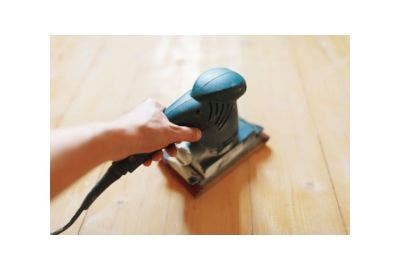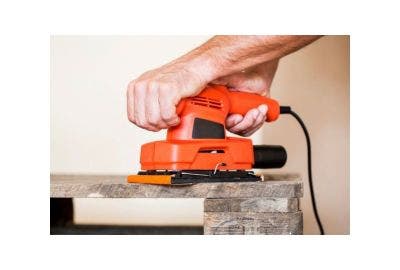For anyone engaged in precision work, whether in woodworking, restoration, or craft projects, detail sanders are indispensable tools.
These versatile devices are specifically designed to access tight spaces and manage intricate details that traditional sanders can't reach. With their compact size and specialised attachments, detail sanders enable meticulous sanding, improving the quality of your work.
In this article, we'll look at the top 10 applications where detail sanders excel, offering practical tips to help you get the most out of your tool. Whether you're a DIY enthusiast or a seasoned professional, mastering the use of a detail sander can lead to superior results.
Refining Intricate Woodwork and Carvings

Detail sanders are particularly well-suited for working on intricate wood carvings and delicate designs.
Their small, precise sanding surfaces allow you to smooth and refine complex areas that would be difficult to reach with larger tools. For intricate carvings, consider using a triangular sanding pad attachment to access tight spaces, and start with medium-grit sandpaper (around 120-grit) to avoid over-sanding. For final smoothing, switch to a fine-grit (240 or higher) to maintain detail.
A light touch helps preserve the wood’s detail, preventing damage and ensuring a smooth, polished surface. This makes detail sanders an essential tool for any woodworker focused on maintaining the quality and detail of their projects.
Smoothing Tight Corners and Edges
Sanding tight corners and edges can be a challenging task, especially when using traditional sanders that struggle to reach confined spaces. Detail sanders, however, excel in these situations, allowing you to easily smooth difficult areas with precision.
The ability to swap out different sanding pads makes it possible to adapt to various corner shapes and angles, providing a uniform finish across the surface. To avoid over-sanding and maintain evenness, it's important to apply consistent pressure and keep the sander moving steadily.
This approach will help you achieve smooth, well-finished corners and edges without compromising the overall quality of your work.
Preparing Surfaces for Staining and Painting
Achieving a professional finish when staining or painting requires meticulous surface preparation, and this is where detail sanders truly shine. These tools are excellent for removing imperfections, old finishes and rough spots, creating a smooth and even surface ready for further treatment.
A detail sander can help you achieve an ideal texture for paint or stain adhesion, ensuring a flawless, long-lasting finish. To get the best results, it's important to use the correct sanding pad and grit, tailored to the specific surface you're working on.
By carefully preparing your surfaces with a detail sander, you set the stage for a polished and high-quality finish.
Restoring and Revitalising Furniture
Detail sanders are invaluable tools when it comes to restoring and revitalising furniture, especially for those pieces with intricate details and delicate areas.
Whether you're dealing with worn finishes or rough surfaces, a detail sander allows you to carefully remove old coatings and smooth out imperfections, breathing new life into your furniture.
When working on delicate areas, such as legs, armrests, or ornate carvings, it's important to select the right sanding attachment to match the contours of the piece. Following up with a finer sanding pass will help make sure that the surface is smooth and ready for refinishing, leaving you with a beautifully restored piece of furniture that looks as good as new.
Removing Old Paint and Varnish

When it comes to stripping old paint and varnish from small or intricate areas, detail sanders are far more efficient and controlled than chemical strippers. They allow for precise removal without risking damage to the underlying material.
A coarse grit (60–80 grit) is effective for the initial removal of thick paint or varnish. Pair it with a pointed-tip attachment for corners and narrow spaces. For finishing, use a medium-grit (120–150) to smooth the surface without damaging the underlying material. It's essential to work slowly and steadily, making sure you don't over-sand or apply too much pressure.
Safety is key when sanding old paint and varnish. Use safety goggles and a dust mask to protect against fine particles, and wear gloves to avoid skin contact with dust. Ensure you’re working in a well-ventilated area or, if possible, use a fan or air purifier to minimise dust accumulation. It may also be possible to use a dust extractor, or specific dust bag compatible with your sander to further help.
Enhancing the Finish of Detailed Moldings
For intricate mouldings with unique profiles, detail sanders excel at providing a smooth finish without erasing fine details. Use light, consistent pressure to keep the original shape intact. These tools allow you to achieve a smooth, even finish on mouldings without losing any of the sharp details that make them unique.
By selecting the right sanding attachments, you can match the contours of the moulding, and that curve and edge are perfectly smoothed. It's important to work slowly and carefully, applying consistent pressure to avoid damaging the surface.
This careful approach helps maintain the quality of the moulding while preparing it for painting, staining, or finishing.
Polishing Small, Hard-to-Reach Areas
Detail sanders are perfect for polishing confined spaces that larger tools can’t access, making them indispensable for tight or narrow areas.
Whether you're restoring the shine to wood, smoothing metal surfaces, or even working with plastics, detail sanders equipped with the appropriate polishing pads can deliver excellent results. Use a soft, foam polishing pad attachment to achieve a glossy finish on wood or metal. For delicate surfaces, start with a polishing compound on a low-speed setting to avoid swirl marks.
For best results, it's important to work slowly and evenly, applying light pressure to avoid any damage to the material. This precision makes detail sanders an essential tool for achieving a professional finish in tight spaces.
Fixing Minor Surface Imperfections
Detail sanders are highly effective for fixing minor surface imperfections, such as scratches, dents and small cracks. When working on small imperfections, always wear a dust mask to avoid inhaling fine particles, especially when using higher grit settings. Use a workbench or a stable surface to keep the sander steady and reduce the chance of mishaps.
By selecting the appropriate grit, you can carefully sand out imperfections, leaving the area smooth and ready for finishing. It’s important to start with a coarser grit to remove the defect and then follow up with a finer grit to blend the repair seamlessly into the rest of the surface.
This method allows your projects to maintain a high-quality finish, free from visible flaws.
Detailing Automotive Interiors and Trim

Detail sanders are also highly useful in automotive detailing, particularly for working on interior surfaces and trim pieces.
These tools allow you to smooth out rough edges, prepare surfaces for repainting, and achieve a professional finish on various materials, such as plastic, vinyl or metal. When working on automotive interiors, it’s important to choose the right attachments and settings to avoid damaging delicate surfaces.
A light touch and steady hand are crucial for maintaining the integrity of the material while providing a smooth, even finish. Whether you're restoring an older vehicle or simply refining the details of a newer one, a detail sander can make the process much more efficient and precise.
Creating Smooth Surfaces for Craft Projects
Detail sanders improve craft projects by creating smooth, precise surfaces on wood, metal, and plastic.
These versatile tools make it easy to prepare surfaces for painting, smooth edges, and refine intricate details. With the right attachments and careful use, detail sanders help achieve a polished, professional finish, making your craft projects stand out.
Detail sanders are versatile tools perfect for intricate tasks across woodworking, restoration and more.
They save time and improve project quality, making them essential for both DIY enthusiasts and professionals. To get the most out of your projects, consider investing in a quality detail sander. Look at Heamar’s range of detail sanders to find the right tool for your needs.
























